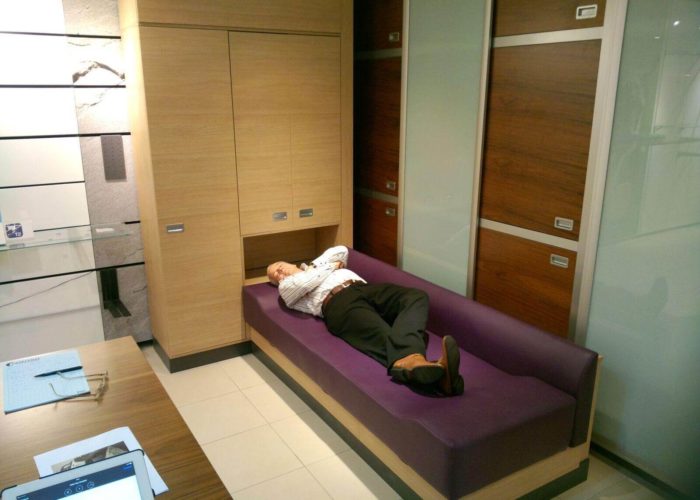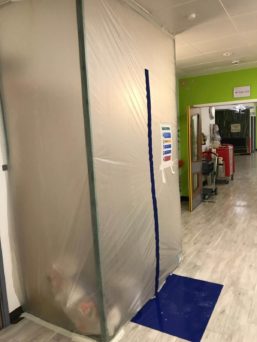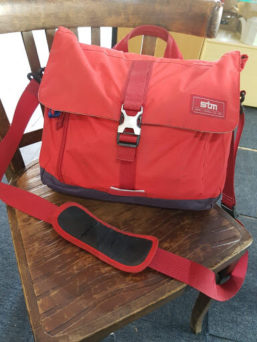
As part of our work, we often spend days in and out of hospitals up and down the country, meeting nurses, management and other hospital staff. We’ve had to develop an innate sense of direction as it’s common that we’ll be met at reception and then marched through the annuls of a large hospital turning left, then right, then left again (or was it right?) and then straight on at the second corridor. We often feel like we need to leave a trail of breadcrumbs to find our way out again!
The other big challenge is finding the person we’re supposed to meet. We can arrive at a reception area having arranged to meet someone at a set time only to find there are a lot of people who look like they might be waiting for us. Arranging to meet someone in a hospital reception is a bit like going on a blind date insofar as not knowing what they look like and these days hardly anyone wears a red carnation. So, we each carry a bright red laptop bag!
It’s small but easily spotted and few others have one. We always tell the person we’re due to meet to look for the bright red laptop bag. It’s easy to spot and so far, hasn’t failed us (it also makes it hard to leave the laptop at home!).
So, why are we telling you this? It’s got nothing to do with hospital interiors. As true as that is, it is indicative of how we work. We look for the simplest and most effective solution for all problems, whether we’re being asked to look at the best image to improve the experience for people in hospital or for the design of a complete ward. Our attention to detail, along with out bright red bags, is always brought to bear on the wards we work to transform for the benefit of everyone who uses them, including the staff.
Solutions that help to look after the people looking after the patients
We’ve worked with hospitals long enough to know that being a nurse is no mean feat, so what details can we include in our designs to save them a little time and make their jobs a little easier?
Parent beds
When you sit on one of our specially designed parent beds in any of the spaces where they’re installed, you may be completely unaware of why the end of the sofa are raised. In fact, at first glance, they may just look like the arms on the end of a sofa. They’re there for a very particular reason though.
When Colin, our director, used to spend time with his son in hospital, he noticed that when he was preparing for an overnight stay there wasn’t always an actual bed for him to sleep on. Sometimes he had to stay on a series of chairs placed together and other times in a chair. For those times there was a bed, getting hold of a standard NHS sheet was easy, as was getting hold of a standard NHS pillowcase. Getting hold of a pillow, on the other hand? Nigh on impossible!
When we set about designing the parent bed, the raised ends were a must. As well as improving a parent’s chances of getting a decent night’s sleep, they also remove the need for nurses to spend their precious time trawling through linen cupboards looking for pillows. This is one less thing for them to worry about, helping to make their lives that little bit easier as the ward settles down and giving them more time to help the patients who need them the most.

Wellbeing Which is Promoted Through Well Designed Furniture
Much like our parent beds, many of the furniture pieces that we use in our ward transformation projects have been designed and made by ourselves, specifically for use in a hospital environment. We design our joinery pieces in such a way that they help to minimise the clinical feel of the room as a whole but we also include a number of small, clever features that promote the clinical function of the room at the same time.
Storage is one of the problems we often need to find a solution for, whether it’s for a patient’s personal effects or for nurses and other clinical staff to store medicines and any other equipment that they need to do their job and to look after their patients. One feature that we always include in our storage units is soft closing doors and drawers and, for furniture that’s designed to move around a ward, quiet castors.
One of the biggest challenges that face nursing staff, particularly those working through the night, is how to keep a ward running and provide the care that patients require without disturbing them while they rest. Making sure these details are included makes it that little bit easier for nurses to continue to keep the ward running and give their patients the care they need to get better without waking them every time they need to fetch something from a drawer or put something back in a cupboard.
It’s not quite glamping, but it’ll do us just fine
 As part of our installation efforts to provide enhancements to hospital interiors, we face numerous challenges to ensure that the safety, security and, of course, the health of patients within spaces we are working isn’t compromised.
As part of our installation efforts to provide enhancements to hospital interiors, we face numerous challenges to ensure that the safety, security and, of course, the health of patients within spaces we are working isn’t compromised.
We often have to cut sections of wooden panelling to ensure the most accurate fit to walls that might be old or a bit wobbly ad that process causes some dust. To ensure we don’t allow the dust to enter the general atmosphere, on a recent project we constructed a plastic cutting tent. This allows the workers on site to move any timber that needs cutting into the tent, cut it there and contain any dust within the tent. This reduces the risk to extremely vulnerable patients to an absolute minimum.
Once the main works are completed, any dust inside the tent is vacuumed up with HEPA filtered machines, bagged into sealed bags and safely removed from the hospital. So, while it’s not exactly ‘glamping’, and there’s no camp fire songs at the end of the day, it means wards can keep working and nurses can keep doing what they do best while we do what we do best.
Having worked on hospital wards for over 10 years, we’ve come to understand how many challenges there are in designing wards. Our aim is always to create environments that promote wellbeing while ensuring that a space supports the staff that work selflessly day in, day out to ensure that patients receive the care they need to get better. In that time, we’ve learnt that small, clever solutions in both the finished space and the way we work to create it make all the difference when it comes to achieving this.
To find out more about how our small, clever design features can help create a better workplace for staff, as well as a better place to get better for patients, get in touch with our design team today.

